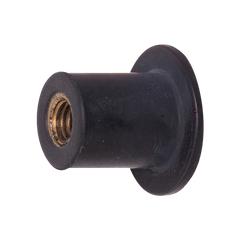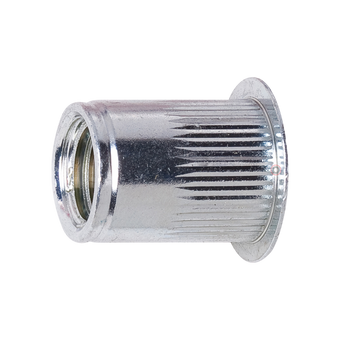Well Nuts vs Nutserts: Differences & When to Use Each

Understanding the difference between well nuts and nutserts.
When do you select a rubber well nut over a steel nutsert? What's the difference? Does one rivet nut type have an advantage over the other? These are some of the questions people seek answered when comparing a rubber well nut to a metal nutsert. There are numerous rivet nut types on the market, and selecting the right one can be a little complicated. In this article we will look into some of misconceptions in the market between a well nut and a nutsert.
In numerous applications, fasteners are the backbone of steel fabrication, construction, vehicle body building, mechanical workshops and so much more. Whether you’re adding accessories, or beefing up the structure, the right fastener can guarantee strength and safety with minimal upkeep. But when you’re working with thinner materials like sheet metal or fiberglass, regular bolts and nuts are not ideal. That’s where nutserts and well nuts become important. These fasteners provide effective vibration resistance and a super strong hold—without needing access behind the panel. This makes them ideal when working with lightweight or thin materials such as sheet metal or fiberglass.
Both well nuts and nutserts are classed as a rivet nut fastener. They provide a strong nut mounting solution for bolting puposes, but with different applications. Well Nuts are a rubber-based fastener offering a cushioned, vibration-resistant hold. They’re a good choice for lightweight or delicate surfaces that might be prone to cracking. Nutserts are metal fasteners that create a sturdy, threaded anchor component in thin materials. They excel in load-bearing applications that need a secure, reusable thread. Today in this article we will look into the advantages and drawbacks of these two specialised fasteners and their application.
What are well nuts?
Well nuts are a specialised fastener intended for lightweight application where vibration or moisture is an issue. They feature a rubber outer body with a brass or steel threaded nut. When you tighten a bolt into a well nut, the rubber compresses and expands, creating a secure hold while also dampening vibrations and sealing out moisture.

Well Nut Installation Diagram

Well Nut Key Details
-
Material: Neoprene rubber body with a metal nut insert, commonly brass or steel.
-
Installation: Insert into a pre-drilled hole, then tighten a bolt to expand the rubber for a tight fit.
-
Main Benefit: Provides a cushioned, sealed connection that’s especially suited for fragile materials.
Advantages of Well Nuts
-
Excellent Vibration Dampening: The rubber body absorbs movement, reducing stress on mounted parts.
-
Seals Against Moisture & Contaminants: Creates a watertight seal that prevents corrosion and keeps sensitive areas protected.
-
Easy Installation: Only requires a drilled hole and a standard bolt—no special tools or rivet guns needed.
Drawbacks of Well Nuts
Well nuts offer clear advantages in vibration-prone and lightweight scenarios, they do have limitations that can make them less effective in high-stress or structural applications:
-
Limited Load-Bearing Capacity: The rubber can deform under high tension or heavy loads, so well nuts aren’t recommended for critical or structural mounting.
-
Prone to Wear & Loosening: In extreme conditions (high heat, constant stress), the rubber may degrade, harden, or lose its elasticity.
-
Not Suited for Heavy-Duty Work: They do not provide the rigid, high-strength hold needed for load-bearing or heavily stressed mounts.
Best Uses for Well Nuts
Well nuts are excellent when vibration resistance, sealing, and quick installation matter most. You’ll often see them in:
-
Lightweight Panel Fastening: Perfect for attaching components without risking damage to delicate materials.
-
Motorcycle Windshields & Plastics: Offers a secure, vibration-resistant hold that reduces stress fractures.
-
Automotive Interiors & Trim: Commonly used in dash panels, consoles, and lightweight body accessories where a bit of flexibility is helpful.
What Are Nutserts?
Nutserts —also known as rivnuts or rivet nuts—are metal tubular fasteners that create a strong, permanent threaded nut in thin or hollow materials. Unlike well nuts, which depend on rubber compression, nutserts are typically made from steel, stainless steel, or aluminum. This gives them a rigid, load-bearing anchor point.

Nutsert Installation Diagram

Nutsert Key Details
When installed, the nutsert expands inside the material, forming a durable and reusable anchor point—ideal for sheet metal, composite panels, or any thin materials where you can’t tap threads directly.
-
Material: Steel, stainless steel, or aluminum.
-
Installation: Requires a rivet nut setter or “nutsert” gun to compress and lock the nutsert in place.
-
Threaded Interior: Allows you to install and remove bolts multiple times without damaging the material
Advantages of Nutserts
Nutserts are the go-to option for heavy-duty, high-strength scenarios where traditional nuts and bolts simply won’t work:
-
Strong, Reusable Threads: Perfect for creating robust threaded inserts in thin materials where welding or tapping just isn’t practical.
-
High Load Capacity: Unlike rubber-based fasteners, nutserts provide superior tensile and shear strength—great for load-bearing projects.
-
Secure Installation: Once nutserts are set, they maintain a tight, rigid hold, resisting vibration and repeated use without loosening.
Drawbacks of Nutserts
While nutserts provide a strong and reliable fastening solution, they do have some downsides to consider:
-
Requires Special Tools – Unlike well nuts, installing rivnuts requires a rivet nut setter tool or nutsert gun, adding extra cost and setup time.
-
No Vibration Dampening – Since rivnuts are rigid metal fasteners, they don’t absorb vibrations. Using washers, rubber gaskets, or thread lockers can help minimise rattling in high-vibration environments.
-
Difficult to Remove – Once installed, nutserts are permanent and can’t be easily removed without drilling them out.
Best Uses for Nutserts
Nutserts are widely used in industries that require strong, lightweight, and durable fasteners. Their versatility makes them ideal for:
-
Securing Brackets & Heavy-Duty Mounting Points – Perfect for installing support brackets, engine bay accessories, and custom fabrication projects.
-
Attaching Accessories to Sheet Metal – Commonly used for mounting roof racks, skid plates, light bars, and fender flares where a strong, reliable hold is essential.
-
Automotive & Aerospace Applications – Found in chassis assembly, body panels, and structural reinforcements where strength and durability are critical.
Choosing a Well Nut or Nutsert for Your Project
The right fastener depends on your project’s specific needs. Well nuts and rivnuts each have unique advantages, but they shine in different applications. In the next section, we’ll compare them side by side, breaking down their strengths, weaknesses, and best use cases to help you make the right choice.
When to Use Well Nuts
Well nuts are the best choice when vibration dampening, simple installation, and moisture sealing matter most. They’re ideal for lightweight applications where flexibility and ease of removal are more important than sheer strength.
-
Best for Vibration-Prone Environments – Perfect for motorcycles, fairings, dashboards, and lightweight panels that experience constant movement.
-
Ideal for Moisture Sealing – The rubber expansion creates a watertight seal, helping prevent water intrusion and corrosion.
-
Great for DIY Installs – No special tools needed—just a pre-drilled hole and a standard bolt, making them perfect for quick repairs or home projects.
Use well nuts when you need a cushioned, easy-to-remove fastener that protects against vibration and the elements.
When to Use Nutserts
Nutserts are the go-to solution when you need a strong, load-bearing, and permanent fastening option. They create durable, reusable threads in thin materials where traditional nuts and bolts won’t work.
-
Best for High-Strength, Load-Bearing Applications – Ideal for securing structural components, mounting brackets, and engine bay installations.
-
Perfect for Metal Surface Mounting – Commonly used for roof racks, skid plates, fender flares, and chassis reinforcements where a solid, reliable hold is crucial.
-
Great for Permanent, High-Reliability Fastenings – Once installed, rivnuts won’t loosen over time, making them the preferred choice for long-term security.
Use nutserts when strength, durability, and reusability are key—especially in automotive and industrial applications.